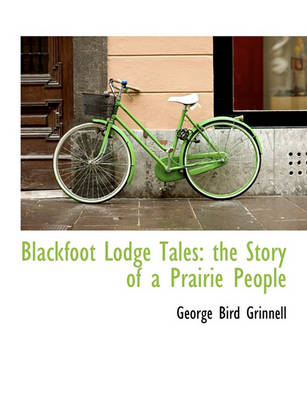Bison Book
3 total works
'These tales 'bring alive the world of the Northern Plains buffalo hunters and warriors"- "Western Folklore". First published in 1892, "Blackfoot Lodge Tales" is based on George Bird Grinnell's extensive personal knowledge of the three tribes of the Blackfoot nation. Grinnell, an ethnologist, writer, editor, explorer, creator of Glacier National Park, and protector of Yellowstone National Park, had great compassion for and understanding of Indians at a time when most men of the frontier were both uninterested in and unable to record the Indians' oral literature. The Blackfoot nation recognized Grinnell as an invaluable friend and entrusted their heritage to his keeping. With that in mind, Grinnell presents as the first half of his book thirty stories of the Blackfeet, recorded as they were told to him - stories of war and adventure, ancient times, natural phenomena, origins of social customs, and tales of creation and the Creator. The remainder of the book deals with the history of the Blackfeet, their daily life and customs, tribal organization, and religion.
'The book is delightful for its presentation of a people whose honest expressions are recorded in all the freshness of their unpolluted, unrefined state. Reading them, one can...smell the Buffalo grass and the wood fires, feel the heavy morning dew on the prairie' - "Western American Literature".
'The book is delightful for its presentation of a people whose honest expressions are recorded in all the freshness of their unpolluted, unrefined state. Reading them, one can...smell the Buffalo grass and the wood fires, feel the heavy morning dew on the prairie' - "Western American Literature".
This beautiful book takes George Bird Grinnell's classic work on the Cheyenne Indians and condenses it into 240 fully-illustrated pages of his most essential writings. Grinell was the long-time editor of 'Field & Stream' magazine and helped to establish both the Yellowstone and Glacier National Parks. During his career he documented several tribes of the old West, including this vivid account of the last of the Cheyenne Indians, who were forced to live out their lives as nomads.
"The value of such a work as Mr. Grinnell has produced can hardly be overstated."
-New York Times
"In his books . Mr. George Bird Grinnell has portrayed [the Indians] with a master hand; it is hard to see how his work can be bettered."
-Theodore Roosevelt
"The value of such a work as Mr. Grinnell has produced can hardly be overstated."
-New York Times
"In his books . Mr. George Bird Grinnell has portrayed [the Indians] with a master hand; it is hard to see how his work can be bettered."
-Theodore Roosevelt
'Grinnell perhaps knew more about Plains Indians and the Indian wars than any non-military white man of his time. He knew many of the Cheyenne and Pawnee warriors...Because so much of this volume is based on material gathered directly from participants, including Pawnees as well as the Norths, it is an important source that can be enjoyed by scholar and general reader' - "American Indian Quarterly". From 1864 until 1877, the Pawnee Scouts, a unique U.S. Army battalion of about a hundred Pawnees, were scouts and soldiers during the height of the Plains Indian wars and earned the respect of prominent generals in the West, including George Crook, Eugene Carr, and Ranald Mackenzie. They were commanded by the famous "fighting Norths." Originally published in 1928, "Two Great Scouts and Their Pawnee Battalion" is based upon Luther's firsthand recollections.The Pawnee Scouts and the Norths helped protect the construction of the Union Pacific Railroad, scouted for the Connor Expedition in 1865 and along the Republican River in 1866, fought the Cheyenne at the Battle of Plum Creek, directed the Carr Expedition that led to the destruction of the Cheyenne Dog Soldier village at Summit Springs, fought in Crook's Campaign against Dull Knife in 1876-1877, and assisted with the campaign following Custer's defeat.
The North brothers became national celebrities, entering a ranching partnership with Buffalo Bill Cody on the Dismal River in central Nebraska. George Bird Grinnell, noted anthropologist and ethnologist, wrote numerous books and was a founder of the Audubon Society. James T. King is the author of "War Eagle: A Life of General Eugene A. Carr".
The North brothers became national celebrities, entering a ranching partnership with Buffalo Bill Cody on the Dismal River in central Nebraska. George Bird Grinnell, noted anthropologist and ethnologist, wrote numerous books and was a founder of the Audubon Society. James T. King is the author of "War Eagle: A Life of General Eugene A. Carr".


